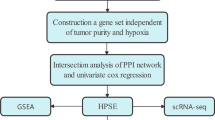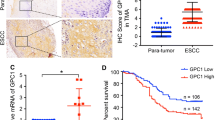Abstract
Background: Heparan sulfate proteoglycans, the main components of the extracellular matrix, are recognized as important components of signal transduction and play an important role in tumor progression. Heparanase (hep) degrades heparan sulfate proteoglycans, but the clinical importance of hep is unclear. In this study, we investigated the clinicopathologic importance of hep messenger RNA (mRNA) expression in esophageal squamous cell carcinoma (ESCC).
Methods: Fresh tumors and noncancerous epithelia were obtained from 57 ESCC patients after esophagectomy. Expression levels of hep and glyceraldehyde-3-phosphate dehydrogenase mRNA were quantitatively analyzed by real-time reverse transcriptase-polymerase chain reaction. Apoptotic cancer cells and microvessel density were evaluated immunohistochemically.
Results: The relative hep mRNA expression level (hep:glyceraldehyde-3-phosphate dehydrogenase ratio) in ESCC was lower than in noncancerous tissue (P < .001). Tumor hep expression decreased according to tumor progression and correlated with the occurrence of apoptotic cancer cells, but not with tumor microvessel density. Moreover, low hep expression correlated with poor patient survival.
Conclusions: Reduced hep mRNA expression might result in abnormal cell growth and correlate with ESCC progression.
Similar content being viewed by others
REFERENCES
Hosch SB, Stoecklein NH, Pichlmeier U, et al. Esophageal cancer: the mode of lymphatic tumor cell spread and its prognostic significance. J Clin Oncol 2001; 19: 1970–5.
Liotta LA, Steeg PS, Stetler-Stevenson WG. Cancer metastasis and angiogenesis: an imbalance of positive and negative regulation. Cell 1991; 64: 327–36.
Hulett MD, Hornby JR, Ohms SJ, et al. Identification of active-site residues of the pro-metastatic endoglycosidase heparanase. Biochemistry 2000; 39: 15659–67.
Vlodavsky I, Friedmann Y, Elkin M, et al. Mammalian heparanase: gene cloning, expression and function in tumor progression and metastasis. Nat Med 1999; 5: 793–802.
Hulett MD, Freeman C, Hamdorf BJ, Baker RT, Harris MJ, Parish CR. Cloning of mammalian heparanase, an important enzyme in tumor invasion and metastasis. Nat Med 1999; 5: 803–9.
Gohji K, Hirano H, Okamura M, et al. Expression of three extracellular matrix degradative enzymes in bladder cancer. Int J Cancer 2001; 95: 295–301.
Endo K, Maehara Y, Baba H, et al. Heparanase gene expression and metastatic potential in human gastric cancer. Anticancer Res 2001; 21: 3365–70.
Yayon A, Klagsbrun M, Esko JD, Leder P, Ornitz DM. Cell surface, heparin-like molecules are required for binding of basic fibroblast growth factor to its high affinity receptor. Cell 2001; 64: 841–8.
Nugent MA, Iozzo RV. Fibroblast growth factor-2. Int J Biochem Cell Biol 2000; 32: 115–20.
Rapraeger AC, Krufka A, Olwin BB. Requirement of heparan sulfate for bFGF-mediated fibroblast growth and myoblast differentiation. Science 1991; 252: 1705–8.
Mundhenke C, Meyer K, Drew S, Friedl A. Heparan sulfate proteoglycans as regulators of fibroblast growth factor-2 receptor binding in breast carcinomas. Am J Pathol 2002; 160: 185–94.
Koliopanos A, Friess H, Kleeff J, et al. Heparanase expression in primary and metastatic pancreatic cancer. Cancer Res 2001; 61: 4655–9.
Cheung IY, Cheung NV. Quantitation of marrow disease in neuroblastoma by real-time reverse transcription-PCR. Clin Cancer Res 2001; 7: 1698–705.
Yajima T, Yagihashi A, Kameshima H, et al. Quantitative reverse transcription-PCR assay of the RNA component of human telomerase using the TaqMan fluorogenic detection system. Clin Chem 1998; 44: 2441–5.
Mitas M, Mikhitarian K, Walters C, et al. Quantitative real-time RT-PCR detection of breast cancer micrometastasis using a multigene marker panel. Int J Cancer 2001; 93: 162–71.
Ikeguchi M, Sakatani S, Ueta T, et al. The expression of thymidine phosphorylase suppresses spontaneous apoptosis of cancer cells in esophageal squamous cell carcinoma. Pathobiology 2001; 69: 36–43.
Nakajima M, Irimura T, Di Ferrante N, Nicolson GL. Metastatic melanoma cell heparanase. Characterization of heparan sulfate degradation fragments produced by B16 melanoma endoglucuronidase. J Biol Chem 1982; 259: 2283–90.
Ikuta M, Podyma KA, Maruyama K, Enomoto S, Yanagishita M. Expression of heparanase in oral cancer cell lines and oral cancer tissues. Oral Oncol 2001; 37: 177–84.
Ogawa K, Nakanishi H, Takeshita F, et al. Establishment of rat hepatocellular carcinoma cell lines with differing metastatic potential in nude mice. Int J Cancer 2001; 91: 797–802.
Kuniyasu H, Oue N, Tsutsumi M, Tahara E, Yasui W. Heparan sulfate enhances invasion by human colon carcinoma cell lines through expression of CD44 variant exon 3. Clin Cancer Res 2001; 7: 4067–72.
Liu D, Shriver Z, Venkataraman G, Shabrawi YE, Sasisekharan R. Tumor cell surface heparan sulfate as cryptic promoters or inhibitors of tumor growth and metastasis. Proc Natl Acad Sci U S A 2002; 99: 568–73.
Elkin M, Ilan N, Ishai-Michaeli R, et al. Heparanase as mediator of angiogenesis: mode of action. FASEB J 2001; 15: 1661–3.
El-Assal ON, Yamanoi A, Ono T, Kohno H, Nagasue N. The clinicopathological significance of heparanase and basic fibroblast growth factor expression in hepatocellular carcinoma. Clin Cancer Res 2001; 7: 1299–305.
Ginath S, Menczer J, Friedmann Y, et al. Expression of heparanase, Mdm2, and erbB2 in ovarian cancer. Int J Oncol 2001; 18: 1133–44.
Suzuki R, Takemura K, Tsutsumi M, Nakamura S, Hamajima N, Seto M. Detection of cyclin D1 overexpression by real-time reverse-transcriptase-method quantitative polymerase chain reaction for the diagnosis of mantle cell lymphoma. Am J Pathol 2001; 159: 425–9.
Author information
Authors and Affiliations
Corresponding author
Rights and permissions
About this article
Cite this article
Ikeguchi, M., Fukuda, K., Yamaguchi, Ki. et al. Quantitative Analysis of Heparanase Gene Expression in Esophageal Squamous Cell Carcinoma. Ann Surg Oncol 10, 297–304 (2003). https://doi.org/10.1245/ASO.2003.05.022
Received:
Accepted:
Issue Date:
DOI: https://doi.org/10.1245/ASO.2003.05.022




